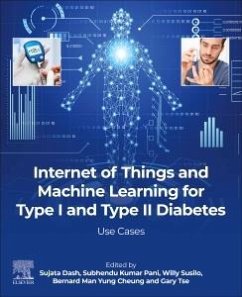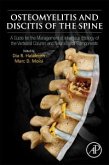Internet of Things and Machine Learning for Type I and Type II Diabetes
Use Cases
Herausgeber: Dash, Sujata; Tse, Gary; Yung Bernard, Cheung Man; Susilo, Willy; Pani, Subhendu Kumar
Internet of Things and Machine Learning for Type I and Type II Diabetes
Use Cases
Herausgeber: Dash, Sujata; Tse, Gary; Yung Bernard, Cheung Man; Susilo, Willy; Pani, Subhendu Kumar
- Broschiertes Buch
- Merkliste
- Auf die Merkliste
- Bewerten Bewerten
- Teilen
- Produkt teilen
- Produkterinnerung
- Produkterinnerung
Internet of Things and Machine Learning for¿Type I and Type II Diabetes: Use Cases provides a medium of exchange of expertise and addresses the concerns, needs, and problems associated with Type I and Type II diabetes. Expert contributions come from researchers across biomedical, data mining, and deep learning. This is an essential resource for both the AI and Biomedical research community, crossing various sectors for broad coverage of the concepts, themes, and instrumentalities of this important and evolving area. Coverage includes IoT, AI, Deep Learning, Machine Learning and Big Data Analytics for diabetes and health informatics.…mehr
Andere Kunden interessierten sich auch für
![Depression and Type 2 Diabetes Depression and Type 2 Diabetes]() Depression and Type 2 Diabetes69,99 €
Depression and Type 2 Diabetes69,99 €![The Ear: Learning How We Hear The Ear: Learning How We Hear]() Josepha ShermanThe Ear: Learning How We Hear30,99 €
Josepha ShermanThe Ear: Learning How We Hear30,99 €![The Science of the Brain The Science of the Brain]() Ari RappoportThe Science of the Brain155,99 €
Ari RappoportThe Science of the Brain155,99 €![Osteomyelitis and Discitis of the Spine Osteomyelitis and Discitis of the Spine]() Osteomyelitis and Discitis of the Spine177,99 €
Osteomyelitis and Discitis of the Spine177,99 €![Essential Guide to Neurodegenerative Disorders Essential Guide to Neurodegenerative Disorders]() Essential Guide to Neurodegenerative Disorders220,99 €
Essential Guide to Neurodegenerative Disorders220,99 €![Environmental Pollution and Brain Biology Environmental Pollution and Brain Biology]() Sultan Ayoub MeoEnvironmental Pollution and Brain Biology133,99 €
Sultan Ayoub MeoEnvironmental Pollution and Brain Biology133,99 €![Microbiome Metabolome Brain Vagus Nerve Circuit in Disease and Recovery Microbiome Metabolome Brain Vagus Nerve Circuit in Disease and Recovery]() Elena L PaleyMicrobiome Metabolome Brain Vagus Nerve Circuit in Disease and Recovery133,99 €
Elena L PaleyMicrobiome Metabolome Brain Vagus Nerve Circuit in Disease and Recovery133,99 €-
-
-
Internet of Things and Machine Learning for¿Type I and Type II Diabetes: Use Cases provides a medium of exchange of expertise and addresses the concerns, needs, and problems associated with Type I and Type II diabetes. Expert contributions come from researchers across biomedical, data mining, and deep learning. This is an essential resource for both the AI and Biomedical research community, crossing various sectors for broad coverage of the concepts, themes, and instrumentalities of this important and evolving area. Coverage includes IoT, AI, Deep Learning, Machine Learning and Big Data Analytics for diabetes and health informatics.
Produktdetails
- Produktdetails
- Verlag: Elsevier Science
- Seitenzahl: 448
- Erscheinungstermin: 9. Juli 2024
- Englisch
- Gewicht: 450g
- ISBN-13: 9780323956864
- ISBN-10: 0323956866
- Artikelnr.: 69769461
- Herstellerkennzeichnung
- Libri GmbH
- Europaallee 1
- 36244 Bad Hersfeld
- gpsr@libri.de
- Verlag: Elsevier Science
- Seitenzahl: 448
- Erscheinungstermin: 9. Juli 2024
- Englisch
- Gewicht: 450g
- ISBN-13: 9780323956864
- ISBN-10: 0323956866
- Artikelnr.: 69769461
- Herstellerkennzeichnung
- Libri GmbH
- Europaallee 1
- 36244 Bad Hersfeld
- gpsr@libri.de
Section 1: Diagnosis
1. An Intelligent Diagnostic approach for diabetes Using rule-based Machine
Learning techniques
2. Ensemble Sparse Intelligent Mining Techniques for Diabetes Diagnosis
3. Detection of Diabetic Retinopathy Using Neural Networks
4. An Intelligent Remote Diagnostic Approach for Diabetes Using Machine
Learning Techniques
5. Diagnosis of Diabetic Retinopathy in Retinal Fundus Images Using Machine
Learning and Deep Learning Models
6. Diagnosis of Diabetes Mellitus using Deep Learning Techniques and Big
Data
Section 2: Glucose monitoring
7. IoT and Machine Learning for Management of Diabetes Mellitus
8. Prediction of glucose concentration in type 1 diabetes patients based on
Machine learning techniques
9. ML-Based PCA Methods to Diagnose Statistical Distribution of Blood
Glucose Levels of Diabetic Patients
Section 3: Prediction of complications and risk stratification
10. Overview of New trends on deep learning models for diabetes risk
prediction
11. Clinical applications of deep learning in diabetes and its enhancements
with future predictions
12. Feature Classification and Extraction of Medical Data Related to
Diabetes Using Machine Learning Techniques: A Review
13. ML-based predictive model for type 2 diabetes mellitus using genetic
and clinical data
14. Applications of IoT and data mining techniques for diabetes monitoring
15. Decision-making System for the Prediction of Type II Diabetes Using
Data Balancing and Machine Learning Techniques
16. Comparative Analysis of Machine Learning Tools in Diabetes Prediction
17. Data Analytic models of patients dependent on insulin treatment
18. Prediction of Diabetes using Hybridization of Radial Basis Function
Network and Differential Evaluation based Optimization Technique
19. An Overview of New Trends On Deep Learning Models For Diabetes Risk
Prediction
Section 4: Dialysis
20. Progression and Identification of heart disease risk factors in
diabetic patients from electronic health records
21. An Intelligent Fog Computing-based Diabetes Prediction System for
Remote Healthcare Applications
22. Artificial intelligence approaches for risk stratification of diabetic
kidney disease
23. Computational Methods for predicting the occurrence of cardiac
autonomic neuropathy
24. Development of a Clinical Forecasting Model to Predict Comorbid
Depression in Diabetes Patients and its Application in Policy Making for
Depression Screening
Section 5: Drug design and Treatment Response
25. Enhancing Diabetic Maculopathy Classification through a Synergistic
Deep Learning Approach by Combining Convolutional Neural Networks, Transfer
Learning, and Attention Mechanisms
26. Pharmacogenomics: the roles of genetic factors on treatment response
and outcomes in diabetes
27. Predicting treatment response in diabetes: the roles of machine
learning-based models
28. Antidiabetic Potential of Mangrove Plants: An Updated Review
1. An Intelligent Diagnostic approach for diabetes Using rule-based Machine
Learning techniques
2. Ensemble Sparse Intelligent Mining Techniques for Diabetes Diagnosis
3. Detection of Diabetic Retinopathy Using Neural Networks
4. An Intelligent Remote Diagnostic Approach for Diabetes Using Machine
Learning Techniques
5. Diagnosis of Diabetic Retinopathy in Retinal Fundus Images Using Machine
Learning and Deep Learning Models
6. Diagnosis of Diabetes Mellitus using Deep Learning Techniques and Big
Data
Section 2: Glucose monitoring
7. IoT and Machine Learning for Management of Diabetes Mellitus
8. Prediction of glucose concentration in type 1 diabetes patients based on
Machine learning techniques
9. ML-Based PCA Methods to Diagnose Statistical Distribution of Blood
Glucose Levels of Diabetic Patients
Section 3: Prediction of complications and risk stratification
10. Overview of New trends on deep learning models for diabetes risk
prediction
11. Clinical applications of deep learning in diabetes and its enhancements
with future predictions
12. Feature Classification and Extraction of Medical Data Related to
Diabetes Using Machine Learning Techniques: A Review
13. ML-based predictive model for type 2 diabetes mellitus using genetic
and clinical data
14. Applications of IoT and data mining techniques for diabetes monitoring
15. Decision-making System for the Prediction of Type II Diabetes Using
Data Balancing and Machine Learning Techniques
16. Comparative Analysis of Machine Learning Tools in Diabetes Prediction
17. Data Analytic models of patients dependent on insulin treatment
18. Prediction of Diabetes using Hybridization of Radial Basis Function
Network and Differential Evaluation based Optimization Technique
19. An Overview of New Trends On Deep Learning Models For Diabetes Risk
Prediction
Section 4: Dialysis
20. Progression and Identification of heart disease risk factors in
diabetic patients from electronic health records
21. An Intelligent Fog Computing-based Diabetes Prediction System for
Remote Healthcare Applications
22. Artificial intelligence approaches for risk stratification of diabetic
kidney disease
23. Computational Methods for predicting the occurrence of cardiac
autonomic neuropathy
24. Development of a Clinical Forecasting Model to Predict Comorbid
Depression in Diabetes Patients and its Application in Policy Making for
Depression Screening
Section 5: Drug design and Treatment Response
25. Enhancing Diabetic Maculopathy Classification through a Synergistic
Deep Learning Approach by Combining Convolutional Neural Networks, Transfer
Learning, and Attention Mechanisms
26. Pharmacogenomics: the roles of genetic factors on treatment response
and outcomes in diabetes
27. Predicting treatment response in diabetes: the roles of machine
learning-based models
28. Antidiabetic Potential of Mangrove Plants: An Updated Review
Section 1: Diagnosis
1. An Intelligent Diagnostic approach for diabetes Using rule-based Machine
Learning techniques
2. Ensemble Sparse Intelligent Mining Techniques for Diabetes Diagnosis
3. Detection of Diabetic Retinopathy Using Neural Networks
4. An Intelligent Remote Diagnostic Approach for Diabetes Using Machine
Learning Techniques
5. Diagnosis of Diabetic Retinopathy in Retinal Fundus Images Using Machine
Learning and Deep Learning Models
6. Diagnosis of Diabetes Mellitus using Deep Learning Techniques and Big
Data
Section 2: Glucose monitoring
7. IoT and Machine Learning for Management of Diabetes Mellitus
8. Prediction of glucose concentration in type 1 diabetes patients based on
Machine learning techniques
9. ML-Based PCA Methods to Diagnose Statistical Distribution of Blood
Glucose Levels of Diabetic Patients
Section 3: Prediction of complications and risk stratification
10. Overview of New trends on deep learning models for diabetes risk
prediction
11. Clinical applications of deep learning in diabetes and its enhancements
with future predictions
12. Feature Classification and Extraction of Medical Data Related to
Diabetes Using Machine Learning Techniques: A Review
13. ML-based predictive model for type 2 diabetes mellitus using genetic
and clinical data
14. Applications of IoT and data mining techniques for diabetes monitoring
15. Decision-making System for the Prediction of Type II Diabetes Using
Data Balancing and Machine Learning Techniques
16. Comparative Analysis of Machine Learning Tools in Diabetes Prediction
17. Data Analytic models of patients dependent on insulin treatment
18. Prediction of Diabetes using Hybridization of Radial Basis Function
Network and Differential Evaluation based Optimization Technique
19. An Overview of New Trends On Deep Learning Models For Diabetes Risk
Prediction
Section 4: Dialysis
20. Progression and Identification of heart disease risk factors in
diabetic patients from electronic health records
21. An Intelligent Fog Computing-based Diabetes Prediction System for
Remote Healthcare Applications
22. Artificial intelligence approaches for risk stratification of diabetic
kidney disease
23. Computational Methods for predicting the occurrence of cardiac
autonomic neuropathy
24. Development of a Clinical Forecasting Model to Predict Comorbid
Depression in Diabetes Patients and its Application in Policy Making for
Depression Screening
Section 5: Drug design and Treatment Response
25. Enhancing Diabetic Maculopathy Classification through a Synergistic
Deep Learning Approach by Combining Convolutional Neural Networks, Transfer
Learning, and Attention Mechanisms
26. Pharmacogenomics: the roles of genetic factors on treatment response
and outcomes in diabetes
27. Predicting treatment response in diabetes: the roles of machine
learning-based models
28. Antidiabetic Potential of Mangrove Plants: An Updated Review
1. An Intelligent Diagnostic approach for diabetes Using rule-based Machine
Learning techniques
2. Ensemble Sparse Intelligent Mining Techniques for Diabetes Diagnosis
3. Detection of Diabetic Retinopathy Using Neural Networks
4. An Intelligent Remote Diagnostic Approach for Diabetes Using Machine
Learning Techniques
5. Diagnosis of Diabetic Retinopathy in Retinal Fundus Images Using Machine
Learning and Deep Learning Models
6. Diagnosis of Diabetes Mellitus using Deep Learning Techniques and Big
Data
Section 2: Glucose monitoring
7. IoT and Machine Learning for Management of Diabetes Mellitus
8. Prediction of glucose concentration in type 1 diabetes patients based on
Machine learning techniques
9. ML-Based PCA Methods to Diagnose Statistical Distribution of Blood
Glucose Levels of Diabetic Patients
Section 3: Prediction of complications and risk stratification
10. Overview of New trends on deep learning models for diabetes risk
prediction
11. Clinical applications of deep learning in diabetes and its enhancements
with future predictions
12. Feature Classification and Extraction of Medical Data Related to
Diabetes Using Machine Learning Techniques: A Review
13. ML-based predictive model for type 2 diabetes mellitus using genetic
and clinical data
14. Applications of IoT and data mining techniques for diabetes monitoring
15. Decision-making System for the Prediction of Type II Diabetes Using
Data Balancing and Machine Learning Techniques
16. Comparative Analysis of Machine Learning Tools in Diabetes Prediction
17. Data Analytic models of patients dependent on insulin treatment
18. Prediction of Diabetes using Hybridization of Radial Basis Function
Network and Differential Evaluation based Optimization Technique
19. An Overview of New Trends On Deep Learning Models For Diabetes Risk
Prediction
Section 4: Dialysis
20. Progression and Identification of heart disease risk factors in
diabetic patients from electronic health records
21. An Intelligent Fog Computing-based Diabetes Prediction System for
Remote Healthcare Applications
22. Artificial intelligence approaches for risk stratification of diabetic
kidney disease
23. Computational Methods for predicting the occurrence of cardiac
autonomic neuropathy
24. Development of a Clinical Forecasting Model to Predict Comorbid
Depression in Diabetes Patients and its Application in Policy Making for
Depression Screening
Section 5: Drug design and Treatment Response
25. Enhancing Diabetic Maculopathy Classification through a Synergistic
Deep Learning Approach by Combining Convolutional Neural Networks, Transfer
Learning, and Attention Mechanisms
26. Pharmacogenomics: the roles of genetic factors on treatment response
and outcomes in diabetes
27. Predicting treatment response in diabetes: the roles of machine
learning-based models
28. Antidiabetic Potential of Mangrove Plants: An Updated Review








